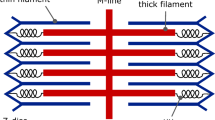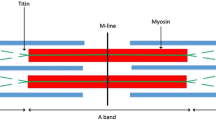Abstract
In this study on decapod crustaceans, we examined the Ca2+- and Sr2+-activation properties of skeletal muscle fibres from an identified proprioceptor, the thoracic coxal muscle receptor organ (TCMRO) and its extrafusal promotor muscle fibres. Proprioceptors and extrafusal muscles were isolated from a walking leg from the crayfish (Cherax destructor) and the rear swimming leg of the mud crab (Scylla serrata). The crayfish and mud crab TCMROs had very low Hill coefficient (n Ca) values (1.86 ± 0.08 and 1.64 ± 0.03, respectively). In comparison to other skeletal muscle fibre types these low Hill coefficients would enable the length of the receptor muscles to be finely controlled over a wide range of [Ca2+]. Maximum force was found to be significantly lower in the TCMROs (crayfish: 5.76 ± 0.98; crab: 4.80 ± 0.56 Ncm−2), compared to their associated extrafusal promotor muscle fibres (crayfish: 10.69 ± 1.63; crab: 20.07 ± 1.98 Ncm−2), which is consistent with their sensory role. The muscle fibres of the crayfish TCMRO had faster contractile properties than the mud crab TCMRO, we discuss how these contractile properties relate to the type of locomotion undergone by each leg. The mud crab ‘red’ promotor and all crayfish promotor fibres were characterised as slow with low Hill coefficients (n Ca: crayfish: 3.22 ± 0.29; crab: 3.34 ± 0.29) and a contractile apparatus with a high sensitivity to Ca2+ (pCa50: crayfish: 6.42 ± 0.03; crab: 6.18 ± 0.03). In contrast the ‘white’ mud crab promotor fibres from the swimming leg had contractile properties that were characteristic of fast fibres with a high mean Hill coefficient (n Ca: 5.27 ± 0.76) and a lower Ca2+ sensitivity (pCa50: 6.03 ± 0.03). The sensitivity of the contractile apparatus to Sr2+ was very low (range of mean pSr50: 4.23 ± 0.03–3.48 ± 0.06) and low force levels were produced in comparison to that produced with Ca2+. The results of this study show that the muscle fibres of the sensory receptor, produce less force and have been adapted to enable the length of the receptor to be finely set in relation to the length of the extrafusal muscle. We discuss how the striated fibres of the receptor have been adapted to perform a sensory role and how this is related to the type of locomotion undergone by the legs. We also discuss how the fibre types of the extrafusal muscle have adapted to the mode of locomotion.
Similar content being viewed by others
References
Ashley CC and Moisescu DG (1977) Effect of changing the composition of the bathing solutions upon the isometric tension-pCa relationship in bundles of crustacean myofibrils. J Physiol 270: 627–652.
Atwood HL (1973) An attempt to account for the diversity of crustacean muscles. American Zoologist 13: 357–378.
Cruse H (1985) Which parameters control the leg movements of a walking insect. I. Velocity control during the stance phase. J Exp Biol 116: 343–355.
Bassler U (1986) Afferent control of walking movements in the stick insect, Cuniculina impigra. I. Decerebrate animals on a treadband. J Comp Physiol A 158: 335–349.
Bush BMH and Cannone AJ (1985) How do crabs control their muscle receptors. In: Barnes WJP and Gladden MH (eds) Feedback and Motor Control in Vertebrates and Invertebrates. (pp. 145–156). Croom Helm, London.
Fink RHA, Stephenson DG and Williams DA (1986) Calcium and strontium activation of single skinned muscle fibres of normal and dystrophic mice. J Physiol 373: 513–525.
Galler S (1989) Ca++ dependent tension development and kinetic parameters in two crustacean muscle fiber types. Pflügers Archives 413: R34
Galler S and Neil DM (1994) Calcium-activated and stretch-induced force responses in two biochemically defined muscle fibre types of the Norway lobster. J Muscle Res Cell Motil 15: 390–399.
Galler S and Rathmayer W (1992) Shortening velocity and force/pCa relationship in skinned crab muscle fibres of different types. Pflügers Archives 420: 187–193.
Hartnoll RG (1971) The occurrence, methods and significance of swimming in the bracyura. Animal Behaviour 19: 34–50.
Head SI and Bush BMH (1991a) Reflex actions of one proprioceptor on the motoneurones of a muscle receptor and their central modulation in the shore crab. J Physiol 437: 49–62.
Head SI and Bush BMH (1991b) Proprioceptive reflex interaction with central motor rhythms in the isolated thoracic ganglion of the shore crab. J Comp Physiol A 168: 445–459.
Mykles DL (1988) Histochemical and biochemical characterization of two slow fibre types in decapod crustacean muscles. J Exp Zool 245: 232–243.
Sillar KT and Skorupski P (1986) Central input to primary afferent neurones in the crayfish, Pasifastacus leniusculus, is correlated with rhythmic motor output of thoracic ganglia. J Neurophysiol 55: 678–688.
Soffe SR (1985) Central coordination of swimming in lower vertebrates. In: Bush BMH and Clarac F (eds) Coordination of Motor Behaviour. (pp. 141–162). Cambridge University Press, Cambridge.
Spirito CP (1972) An analysis of swimming behavior in the portunid crab Callinectes sapidus. Mar Behav Physiol 1: 261–276.
Stephenson DG and Williams DA (1980) Activation of skinned arthropod muscle fibres by Ca2+ and Sr2+. J Muscle Res and Cell Motil 1: 73–87.
West JM, Humphris DC and Stephenson DG (1992) Differences in maximal activation properties of skinned short-and long-sarcomere muscle fibres from the claw of the freshwater crustacean Cherax destructor. J Muscle Res and Cell Motil 13: 668–684.
West JM and Stephenson DG (1993) Ca2+ and Sr2+ activation properties of skinned muscle fibres with different regulatory systems from crustacea and rat. J Physiol 462: 579–596.
Author information
Authors and Affiliations
Rights and permissions
About this article
Cite this article
Parkinson, A.L., Bakker, A.J. & Head, S.I. Ca2+- and Sr2+-activation properties of muscle fibres from a muscle receptor organ and the associated extrafusal muscle of the crab and crayfish. J Muscle Res Cell Motil 21, 663–671 (2000). https://doi.org/10.1023/A:1005656528208
Issue Date:
DOI: https://doi.org/10.1023/A:1005656528208




